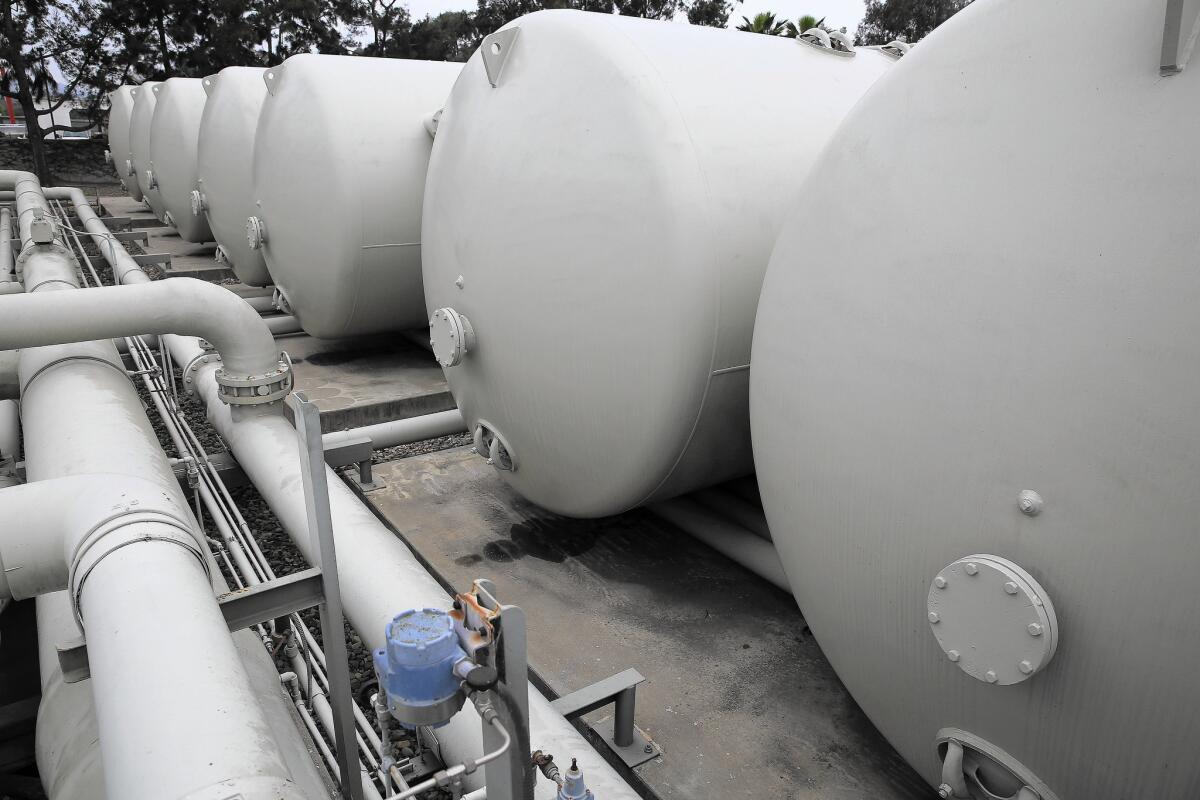Santa Barbara working to reactivate mothballed desalination plant

- Share via
Reporting from Santa Barbara — California’s four-year drought created the statewide mantra: “Conserve, conserve, conserve.” But this coastal city can soon add another word to its water-related lexicon: desalinate.
Santa Barbara owns a mothballed plant — built more than 20 years ago during another severe drought — that can turn seawater into drinking water. But it was never used beyond a tryout phase before steady rain began falling again. Now, officials are working to press the Charles E. Meyer Desalination Facility back into service as the city’s reservoirs continue to diminish.
The city plans to spend up to $40 million to modernize and reactivate the plant, which was closed in 1992 when the last drought ended. It is among a number of desalting projects being considered along the California coast, including in Huntington Beach and the Monterey Peninsula.
In Cambria, a hybrid desalination plant that began operating in November treats brackish water to make it drinkable. And the nation’s largest desalination plant is being built in Carlsbad for $954 million.
Although it may seem natural to think the Pacific Ocean could be the answer to California’s water crisis, experts say a stampede toward desalination is unlikely.
“It has two big disadvantages: It’s really expensive and it’s energy-intensive,” said Henry Vaux Jr., a UC Berkeley professor emeritus of resource economics who contributed to a 2008 National Research Council report on desalination.
It could also put elected leaders in the unenviable position of sticking customers with expensive desalination bills should stormy weather return.
“Given the time it takes to come up with a plant, including permitting and construction, the drought will probably be over by the time it’s built,” said Heather Cooley, water program director of the Pacific Institute, a nonprofit that conducts research on natural resources.
That’s what happened in Santa Barbara in the early 1990s, when officials began constructing the $35-million plant. At that time, communities were so desperate for water, Ventura even floated the notion of towing icebergs down the coast from Alaska to provide some relief. State experts said the idea had been studied and quickly discarded.
Heavy rains came before Santa Barbara’s desalination plant was finished nine months later, and it was never used beyond the test phase. But the city kept up its maintenance schedule over the last two decades, with the idea that it could be brought online again in another drought.
That time arrived last September when the city’s main reservoir, Lake Cachuma, fell to less than 30% capacity and the city tightened restrictions on customers’ water use to encourage conservation. The City Council voted unanimously that month to pursue reopening the plant in the fall of 2016.
“The council policy was to go to desalination as an absolutely last resort, and this is a last resort,” Santa Barbara Mayor Helene Schneider said in an interview. “The exceptional drought has accelerated this year, and we need to be ready and have desal online when we need it.”
If the plant is reactivated next year, it would produce enough water to make up about 30% of Santa Barbara’s demand, said Joshua Haggmark, the interim water resources manager.
Santa Barbara already reduced its water usage by 24% in January, compared to the same month in a normal year, Haggmark said. If current conditions persist, the city will probably ramp up its water restrictions to the next level, including a possible moratorium on watering lawns, he said.
“People have really stepped up to the plate,” Haggmark said, adding that strong conservation numbers do not lessen the necessity for desalination. “This is not a knee-jerk response.”
Desalinated water will cost about a third more than Santa Barbara’s imported water because on top of the estimated $40 million it could take to open the plant, it could cost $5.2 million a year to keep it running.
That means water users could see a significant increase in their water bills this summer if the city moves forward. Monthly bills could increase from $78 to $108 for an average household using 1,200 cubic feet. A cubic foot equals about 7.5 gallons.
The Santa Barbara plant will produce fresh water through reverse osmosis, an energy-intensive process that separates salts and contaminants from seawater by forcing it through sand filters and tightly coiled synthetic membranes. The salt is returned to the ocean as brine.
But environmentalists complain that the Santa Barbara plant will damage the marine environment by sucking microorganisms, fish eggs and plankton, which form a critical part of the food chain, into water intake pipes in the open ocean.
They would rather see intake pipes placed under the ocean floor, which they said would be less harmful to aquatic life.
The city has agreed to study alternative methods for taking in ocean water, but it is not required under various state permits to change anything.
“We don’t think desalination is a smart solution to the drought,” said Kira Redmond, executive director of Santa Barbara Channelkeeper. “But if they’re going to do it, we’re asking them to operate it in the most environmentally sound way possible, using modern technology.”
Redmond said alternatives, such as capturing storm water and recycling wastewater, should be tried first.
“We completely disagree that they’ve exhausted all their other options,” Redmond said. “We don’t agree that it’s a last resort.”
Twitter: @amcovarrubias
More to Read
Sign up for Essential California
The most important California stories and recommendations in your inbox every morning.
You may occasionally receive promotional content from the Los Angeles Times.











